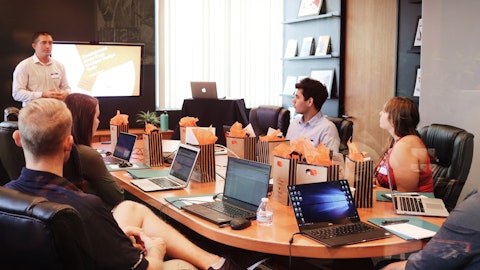Coca-Cola FEMSA, S.A.B. de C.V. (NYSE:KOF) Q1 2023 Earnings Call Transcript April 27, 2023
Coca-Cola FEMSA, S.A.B. de C.V. beats earnings expectations. Reported EPS is $1, expectations were $0.96.
Unidentified Company Representative: 100 basis points year-on-year. This compression was driven mainly by increases in raw material costs, such as sweeteners and concentrate in Mexico. These effects were partially mitigated by our top line growth, raw material hedging initiatives, and the appreciation of the Mexican Peso as applied our dollar-denominated raw material costs. Our operating income for the division increased 1.2%, resulting in a margin contraction of 220 basis points. This was driven mainly by increases in costs and operating expenses such as labor, marketing and maintenance that were partially offset by an operating foreign exchange gain in Mexico. Finally, our EBITDA margin for the division declined 330 basis points.
Moving on our South America division, volumes increased 3.8%. This increase was driven by 4.3% growth in Brazil, 4.5% growth in Argentina and 14.8% growth in Uruguay. This growth was partially offset by a stable volume performance in Colombia. On a comparable basis, excluding volumes of CVI in Brazil, the division’s volume would have increased to 0.8%. Our revenues for the South America division grew 6.6%, driven by our volume growth and revenue management initiatives. These factors were partially offset by the unfavorable currency translation effects of most of our operating currencies in the division into Mexican pesos. When excluding currency translation and M&A effects are comparable total revenues would have increased to solid 27.5% during the quarter.
Gross profit in South America increased 11%, resulting in a 160 basis point margin expansion. This was driven mainly by the positive operating leverage, resulting from volume growth and favorable mix effects. These effects were partially offset by an increase in raw material costs such as PET and sweeteners. Operating income for the division increased 43.3%, and margin expanded 290 basis points as compared to the previous year. This increase was driven mainly by the combination of our positive top line operating leverage and tight expense control across our operations that offset higher fixed cost and expenses. Finally, EBITDA in South America increased 22.9% resulting in an EBITDA margin expansion of 220 basis points. Moving on to our financial results, the quarterly comprehensive financing results recorded an improvement of 36% as compared with the previous year.
This reduction can be explained mainly by a favorable comparison base that included a one-off market value loss and financial instruments of Ps. 936 million recorded during the first quarter of last year. This loss was recognized as a result of interest rate increases and its effects on floating rates denominated debt during that period. By normalizing this effect, our comprehensive financial results would have improved 9.2% this quarter, driven mainly by an increase in interest income. These effects were partially offset by a higher foreign exchange loss driven by the appreciation of the Mexican peso as applied to our U.S. dollar cash position and a lower gain in hyperinflationary subsidiaries. Finally, our controlling net income increased 35.3% to reach Ps. 7.1 billion resulting in earnings per share of $0.23.
As we mentioned during our previous earnings call, one of our priorities is to continue allocating capital toward supporting our organic growth. For this reason, our CapEx expectation for 2023 as disclosed in our 20th Annual Report is a ratio of around 8% of revenues. These investments will be primarily focused on increasing our manufacturing and distribution capacity. Our projects include installing seven new production lines this year and increasing our warehouse capacity through new distribution centers and warehouse expansions. Over the next three to five years, we expect to increase our warehouse capacity by 30% and our manufacturing capacity by 50% – 15% to continue supporting our growth. Finally, as announced on March 27, our annual general shareholder’s meeting approved the cash dividend equivalent to Ps. 5.8 per unit, which represents an increase of 6.8% as compared with the previous year’s dividends.
With that, operator, we are ready to open the call for questions.
Operator: Thank you. We’ll take our first question from Ricardo Alves from Morgan Stanley. Your line is open. Please go ahead.
Ricardo Alves: Hello, gentlemen. Can you hear me?
Ian Craig: Yes, Ricardo. Hello. We hear you fine.
Ricardo Alves: Thank you. It was just double checking. I had a few a few issues. Thanks for the call. I had a couple of questions on perhaps a question to Ian. We’ve been discussing this a lot with investors Honduras and FEMSA. So just wanted to get an update from you on the overall role of Coke FEMSA, the importance of Coke FEMSA in the context of the FEMSA forward, we already discussed this in other instances, but from your perspective, given the recent meetings that you’ve had working closer, OXXO – with OXXO and overall FEMSA operations. What makes you more bullish today versus the last conversation that we had a couple of months ago would assume that Honduras in Mexico is still the main opportunity. We’ve also discussed this in the past, but I don’t know if there’s any other details that you can share with us with ongoing process – progress that you’ve guys have already achieved or envision to achieve.
I’m not sure if there’s anything new for you to share on the digital initiatives, premium and spin, which is also another key focus from investors from the FEMSA perspective, but also trying to come to terms with what is the upside from cost as well. So just a broader update on your Coke FEMSA’s role in this broader FEMSA strategy, that’s the first question. Second question, this one, much quicker, Mexico margins, appreciate a very strong top line performance, very strong execution. Just wanted to get a little bit of update on the profitability outlook that you have for the rest of the year, if you still envision a scenario where you’re able to protect margins year-over-year, and if that’s the case, just a little bit more details on the cost front.
Q&A Session
Follow Coca Cola Femsa S A B De C V (NYSE:KOF)
Follow Coca Cola Femsa S A B De C V (NYSE:KOF)
Receive real-time insider trading and news alerts
Ian Craig: Hello. Thank you for the question. First, Ricardo, on the B2B front or digital collaboration front. For us in Honduras for us, we bring to the table the largest B2B or traditional trade access in Mexico by far in Latin America as well. And at the same time, FEMSA Digital has the most or the most advanced in our opinion FinTech or wallet offering, as well as a very interesting and powerful loyalty offering. So we are developing and looking to integrate these offerings in our B2B platform. This is going to take some time to bring to fruition, but those are two of the areas where we clearly cannot value to both sides, FEMSA Digital as well as Coke FEMSA in our B2B platform. We want to become that one-stop shop to our B2B customers, and for that, these value-added services in FinTech as well as making our loyalty points more powerful by leveraging steam premier is something that’s very interesting to us in our digital platform.
When you talk about margins I think we mentioned this in our prior call, we – the first quarter was the toughest comps when we – where we expected the most pressure. This pressure should be reduced gradually and turned into a margin expansion by the fourth quarter. Gerry, would you like to go into the details of the cost impact so that we could share that Ricardo, please?
Gerardo Cruz Celaya: Yes. Ricardo, addressing the margin impact, we had unusual higher expenses related to labor marketing and maintenance during the first quarter. As Ian mentioned, with a tough comparison versus margins last year. For the fourth quarter, we expect an expansion of margins ending the year with margins for the full year at similar levels where margins were at the end of 2022. And this is Mexico specifically as you saw in our report; South America division presented a very healthy margin expansion.
Ricardo Alves: That’s very helpful. Thank you, gentlemen.
Operator: We will take our next question from Ben Theurer from Barclays. Your line is open. Please go ahead.
Ben Theurer: Yes. Thank you very much, and good morning. So I want to bring it down to South America. Obviously very strong volume and performance in some regions are a little softer. But if we take a look just at the results in their respective local currency terms, and particularly we take a look at the profitability. What’s been like the key driver of these massive profitability gains? I mean, margin expansion was really big in the quarter, and were there some things that were more of like a one-time nature or do you think just by having reached certain levels of volume in some of that – some of these countries that the profitability can actually be sustained at these levels or maybe even further expanded? You just alluded a little bit to it on the strength, but maybe to dig a little better into – a little more detail into the margin evolution here in South America. That would be much appreciated.
Ian Craig: Thank you, Ben for your question. South America did perform quite well in terms of profitability and margin expansion. But good news here is that it was mainly driven by a top line performance both in volume and favorable mix performance. The expansion and margin was more than 200 basis points for that division. And particularly Brazil and Argentina were able to absorb certain fixed expenses by the increase in sales delivering a positive operating income in the region. Also during the quarter, we had favorable raw material environment in most countries in South America, and we expect that raw material environment to continue to be favorable for the remainder of the year. Probably potential impact in sweeteners that have been the nagging impact in our P&L. But the rest of the raw material environment seems to be pretty positive, stable to positive for the remainder of the year.
Ben Theurer: Okay. So perfect. Thank you very much.
Ian Craig: Thank you, Ben.
Operator: We’ll take our next question from Alvaro Garcia from BTG. Your line is open. Please go ahead.
Alvaro Garcia: Hi gentlemen. Thanks for the space for questions. First I was – two questions. First, I was wondering if you could just remind me sort of sweetener dynamics in each of your main markets, so raw sugar in Brazil versus fructose in Mexico and how you can hedge each of these respective markets. And my second question is in Argentina. Gerry, I was wondering if you could sort of walk us through whether you are taking dividends out of Argentina at the moment and sort of what the outlook has given the FX environment there. Thank you.
Gerardo Cruz Celaya: Thank you, Alvaro for your question. I’ll start with the sweetener situation and I’ll give you a few details. As I was mentioning in my previous to answer Ben’s question. Sweeteners is the raw material that we are a little bit more concerned with particularly in sugar for Brazilian, why we have a pretty healthy hedge position, Brazil very close to 40% of our requirements for the whole year at a significant premium to – or below the current market price significantly as well as in rural white where that position is close to 60% of our requirements. In the case of fructose for Mexico, which is the main operation where we use fructose, we have more than 90% of our requirements for the year already hedged at a very competitive price, which is also reducing any worry for us for the remainder of the year on that front.
We have the expectation that sugar prices will continue to be tight for the remainder the year, mainly due to the sugar world environment being pretty tight and countries that are swing players in the sugar market like India, not exporting that much sugar to the market. So that’s where we are in terms of sweeteners. For your question regarding Argentina dividends, as you know, it’s a very complex environment to be able to extract dividends from Argentina. We’ve been following the market and obviously taking advantage of any opportunities that present in the local market to be able to use our excess cash to invest in our organic growth requirements. And given that performance in Argentina has been very good for the last at least two years.
We have the good problem of having to create capacity to serve a very positive market and protect our excess cash from many adverse impacts that it can have by foreign currency depreciation.
Alvaro Garcia: Great, thank you.
Operator: We’ll take our next question from from Goldman Sachs. Your line is open. Please go ahead.
Unidentified Analyst: Yes. Hi. Good morning, everyone. Thanks also for taking the question. I would just like to go back once again to the discussion on margins, right, specifically in Mexico. Fully appreciate that the commodity prices are still a headwind, then this should normalize going forward. But if I try to break down the bulk of emerging compression there, it’s essentially a G&A, right? And I think Gerry pointed out some of the driver that are impacting the quarter. I’ll just like to understand, when you share and rate the division of margins potentially improving by year end or being quite as familiar basis, what you’re assuming for this, right? Is this some room to improve the SG&A and reduce expenses? Or would it require further pricing for you to reach this more normalizing margin level?
And if this is the case, how confident you are on the Mexican consumption backdrop, right? Volumes, I guess per most of the Mexican bottles are in the first quarter, right, have been surprising on the upside. So it seems there is a statement still there, but just wanted to hear a little bit from you how confident you are that elasticity could bringing relatively below going forward? Thank you very much.
Ian Craig: Thank you, Tiago. We certainly expect cost SG&A to normalize for the remainder of the year. As we mentioned during the script of the call, first quarter was the toughest comp in terms of margin as compared to last year. So we expect better cost absorption. The cost that we experienced during the first quarter were a bit unusual and that impact we do not expect to maintain for the remainder of the year. And as mentioned as well, by the fourth quarter, having an expansion in margins and ending the year at very similar levels of margin where we ended the prior year.
Operator: We’ll take our next question from Emiliano Fernandez from . Your line is open. Please go ahead.
Unidentified Analyst: Hi, hello, thanks for taking my question. Just a quick one here, regarding Mexico, very impressive volumes there. Did you give any discretion or breakdown on the evolution by month? And also have you seen – how you seen the performance in April? And also another one regarding profitability in Mexico? Just a follow up here. You said you’re expecting to improve their quarter-by-quarter going forward, are you expecting any price increases there to drive a better operating leverage? Or are you still comfortable with the carryover that you already have?
Ian Craig: Thank you for your question, Emiliano. For the first part, in terms of volume as we stated in our fourth quarter call, we – for this year, we are very focused on growth. We’re trying to considering that the slowdown in economic activity in globally and throughout our region, we’re very focused in maintaining the competitive position of our portfolio promoting volume growth. In that sense going into the second part of your question, we are very – we’re going to be very selective in any pricing action that we take, focusing a lot more on driving favorable mix, improving prices through mix, rather than being very aggressive in pricing. We obviously will take – will take care of internal inflation impacts, but we’re being very careful in trying to promote growth and maintaining a competitive positive position.
Gerardo Cruz Celaya: I just wanted to mention that, performance during the quarter in Mexico was – as Jerry mentioned, was solid and was consistent pretty much across the quarter. And so far during April, I think what we can say is that we have seen a continuation of that performance, of that resilient and solid performance in Mexico.
Unidentified Analyst: That’s all I had. Thank you.
Operator: We will take our next question from Rodrigo Alcantara from UBS. Your line is open. Please go ahead.
Rodrigo Alcantara: Hi. Good morning. Thanks for taking my question. Ian, so the first one I would say on , I mean just curious maybe is large quarter, right in northern and south territories would be kind of like synergistic for you guys. Just curious if at some point it was on the table, a full acquisition of the FEMSA’s important operations instead of just the water operations? That would be my first question. The second one just to confirm, you mentioned spec increase manufacturing capacity by 15% and warehouse capacity by 30%, right? And if that’s the case in which region are you going do that? You will be focusing on Brazil next or on a consolidated basis? This will be my two questions. Thank you.
Ian Craig: Hi, Rodrigo. Sorry, but the first question we did catch your second question, but I think the first question was not that clear. So if you could first repeat your first question and then we’ll answer that and then go onto your second one. Can you repeat your first?
Rodrigo Alcantara: Yes, sure. Yes, sorry. Sorry about that. My question was on the FEMSA right. My question was at some point what’s the possibility for you to acquire the full body operations of FEMSA, not just that, water segment but the full operations, the water operations of the FEMSA was that in consideration in this deal or you were not looking for that possibility? That was my question. I don’t know if it was clear.
Ian Craig: Perfect, Rodrigo. On the first question this transaction that we closed last year was a very specific transaction that we were – that made a lot of sense because it was in our territories. It helped us create a capability that we didn’t have in that region to take advantage of the very good competitive position of that jug-water business in that region to strengthen our capability of serving the direct-to-consumer market. That is the market that we’re focusing out on throughout Mexico. So that’s the extent of that operation and what we are looking at for any foreseeable future. Regarding your second question, our creation of manufacturing and warehouse capacity, I think, the good thing about this is that it’s a good problem that we have throughout our operations with a lot of focus, I would say in our four largest volume markets, which are Mexico, Brazil, Colombia, and Guatemala.
All of those four markets are very close to operating at full capacity, both in manufacturing and warehouse. But this is a problem that we see throughout our operations and given that we’re promoting growth and you’ve seen it with our numbers, we are expecting to have to continue investing to create that capacity to serve this growth environment that we’re facing. And obviously coupled with our multi-category commercial platform initiative, which also needs to be obviously supported with the correct capacity to serve this market.
Rodrigo Alcantara: Okay. That’s great. And just – very quickly on the very nice to see the growth you put there on the beer segment. You can comment perhaps break by pricing volumes and some comments about the performance of the brand and that you can comment us about that line, about the beer industry would be also very helpful?. Thank you very much.
Gerardo Cruz Celaya: Sure. I’m sure Rodrigo. Yes on beer definitely during our previous call, Ian expanded now a little bit on what the trends have been across different segments from premium, mainstream and economy. And during the first quarter, we have seen a continuation of that. Now economy we are doing well, but it’s a segment that has been becoming smaller, so we we’re gaining share there. And also, pretty much in line in the other segments, mainstream and premium with also what Heineken recently disclosed for trends for the first quarter. So all in all, we’re focusing on the portfolio opportunities that we have. Eisenbahn as you know, is a brand that we are betting a lot on in the market. It’s a brand that has a lot of potential great recipe as well.
So, we’re expanding its coverage, so as well. It’s a brand that as Ian mentioned in February now, it’s a brand that was not very present across our territories. Obviously a small brands, but we are expanding coverage as well and leveraging those brands now. And also what we’re doing with Australia dilution. So all in all, it’s in general a first quarter that is in line with, with our expectations and in line with the trends that Ian also described for beer in Brazil last quarter.
Rodrigo Alcantara: Okay, that’s helpful. Thank you very much.
Operator: We’ll take our next question from Ricardo Alves from Morgan Stanley. Your line is open. Please go ahead.
Ricardo Alves: Yes. Thanks for the follow up. A quick one. It’s actually just to double check. I think you mentioned in the preliminary remarks your CapEx expectation for the year. But just wanted to make sure that, that I got that number right around 8% of revenues. So just wanted to double check that I asked this because we noticed FEMSA 20-F earlier this week, I think that it had a higher budget for cost, CapEx and what we expected. So just wanted to double check with you what is the most likely set out for CapEx this year and perhaps next? Thank you.
Gerardo Cruz Celaya: Yes of course, Ricardo. We have a range of 8% to 9% of revenues FEMSA and I think was mentioned, the higher end of the range of the 8% to 9%. But that’s where we are. And I think we spoke about this a little bit on our last call that this expectation for this year, we expect to continue for the following at least two years where we’re trying to build this capacity to serve the growth requirements of the business.
Ricardo Alves: Very helpful. Thank you.
Operator: There are no further questions on the line, sir. Please proceed.
Gerardo Cruz Celaya: Thank you. Thank you very much for your confidence and interest in Coca-Cola FEMSA and for joining us on today’s earnings call. As always, our investor relations team is available to answer any of your remaining questions, and we look forward to speaking again soon.
Operator: Thank you for joining today’s call. You may now disconnect.
Follow Coca Cola Femsa S A B De C V (NYSE:KOF)
Follow Coca Cola Femsa S A B De C V (NYSE:KOF)
Receive real-time insider trading and news alerts





